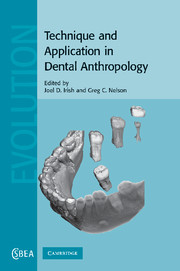Book contents
- Frontmatter
- Contents
- Contributors
- Acknowledgments
- Section I Context
- Section II Applications in assessing population health
- Section III Applied life and population history
- 9 Charting the chronology of developing dentitions
- 10 Dental age revisited
- 11 Primate dental topographic analysis and functional morphology
- 12 Forensic dental anthropology: issues and guidelines
- 13 Inter- and intra-specific variation in Pan tooth crown morphology: implications for Neandertal taxonomy
- 14 The quantitative genetic analysis of primate dental variation: history of the approach and prospects for the future
- Section IV Forefront of technique
- Index
- References
14 - The quantitative genetic analysis of primate dental variation: history of the approach and prospects for the future
Published online by Cambridge University Press: 12 September 2009
- Frontmatter
- Contents
- Contributors
- Acknowledgments
- Section I Context
- Section II Applications in assessing population health
- Section III Applied life and population history
- 9 Charting the chronology of developing dentitions
- 10 Dental age revisited
- 11 Primate dental topographic analysis and functional morphology
- 12 Forensic dental anthropology: issues and guidelines
- 13 Inter- and intra-specific variation in Pan tooth crown morphology: implications for Neandertal taxonomy
- 14 The quantitative genetic analysis of primate dental variation: history of the approach and prospects for the future
- Section IV Forefront of technique
- Index
- References
Summary
Introduction
From the size and shape of teeth we can learn much about an animal's diet, gain some insight as to how it interacted with its conspecifics and environment, and draw conclusions about its phylogenetic placement. Consequently, primate dental variation has been the focus of an immense amount of research (as evidenced by this volume). These adaptive and phylogenetic scenarios rely on the assumption that variation in the dental phenotype is heritable, or rather, that this variation can be passed on from generation to generation as selection filters through the available phenotypic variance.
In this chapter, we discuss the history of research that tests this hypothesis through quantitative genetic analyses. We will focus attention on analyses of crown morphology with the aim of summarizing what is currently known and unknown about the extent to which dental variation is influenced by genetic factors. And last, we discuss two directions through which quantitative genetics will further enhance our understanding of the evolution of our ancestors and closest relatives.
Quantitative genetics
Quantitative genetics is concerned with the inheritance of those differences between individuals that are of degree rather than of kind, quantitative rather than qualitative. These are the individual differences which, as Darwin wrote, “afford materials for natural selection to act on and accumulate …” An understanding of the inheritance of these differences is thus of fundamental significance in the study of evolution and in the application of genetics to animal and plant breeding.
(Falconer, 1989, p. 1)- Type
- Chapter
- Information
- Technique and Application in Dental Anthropology , pp. 317 - 346Publisher: Cambridge University PressPrint publication year: 2008
References
- 26
- Cited by



